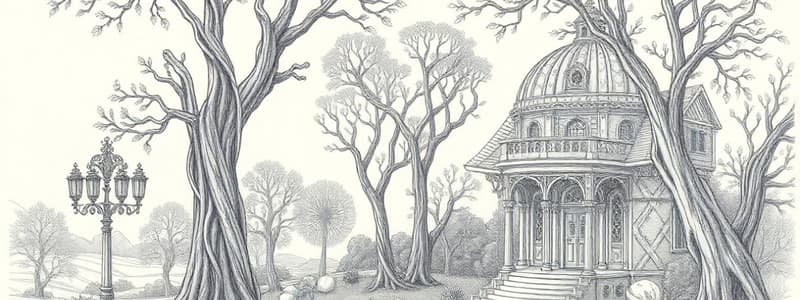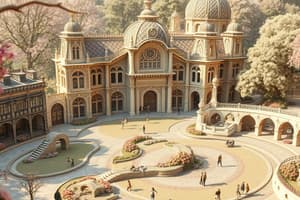Podcast
Questions and Answers
What do lines primarily represent in various objects around us?
What do lines primarily represent in various objects around us?
- Shapes and forms only
- Shadows and reflections only
- Textures and values only
- An extension or prolongation of a point (correct)
Which of the following is NOT a characteristic of straight lines?
Which of the following is NOT a characteristic of straight lines?
- Can be horizontal
- Can be bent (correct)
- Can be diagonal
- Can be vertical
Which line type is considered irregular and can vary in shape?
Which line type is considered irregular and can vary in shape?
- Vertical Lines
- Straight Lines
- Diagonal Lines
- Curved Lines (correct)
What is a key purpose of using lines in landscape sketching?
What is a key purpose of using lines in landscape sketching?
What is the definition of 'plein air' in the context of sketching?
What is the definition of 'plein air' in the context of sketching?
What primary style of drawing is focused on in the previous lesson related to landscapes?
What primary style of drawing is focused on in the previous lesson related to landscapes?
Minor details in a landscape sketch, such as trees and clouds, are typically added after which stage?
Minor details in a landscape sketch, such as trees and clouds, are typically added after which stage?
Which type of line is described as being bent?
Which type of line is described as being bent?
What additional elements are now commonly included in landscape drawings?
What additional elements are now commonly included in landscape drawings?
What is the most basic element of art that is essential for sketching?
What is the most basic element of art that is essential for sketching?
What defines the foreground in a landscape artwork?
What defines the foreground in a landscape artwork?
Which color scheme involves only one color but with different shades?
Which color scheme involves only one color but with different shades?
What is the role of the horizon line in one-point perspective drawing?
What is the role of the horizon line in one-point perspective drawing?
Which of the following best describes analogous colors?
Which of the following best describes analogous colors?
In the context of art principles, what does harmony refer to?
In the context of art principles, what does harmony refer to?
What best describes split complementary colors?
What best describes split complementary colors?
Which term describes the visual movement that encourages the viewer's eye to travel across an artwork?
Which term describes the visual movement that encourages the viewer's eye to travel across an artwork?
Which statement correctly identifies a characteristic of the middle ground in landscape artwork?
Which statement correctly identifies a characteristic of the middle ground in landscape artwork?
What is the definition of proximity in art?
What is the definition of proximity in art?
What is primarily established by a one-point perspective drawing?
What is primarily established by a one-point perspective drawing?
Flashcards
What is a line?
What is a line?
A line is the basic element of art. It's an extension or prolongation of a point, like pulling a piece of clay.
Types of lines
Types of lines
Lines can be straight, curved, or wavy. Straight lines are not bent, and curved lines are bent. Wavy lines are like a series of small curves.
Sketching
Sketching
Sketching is a freehand or informal drawing, usually done quickly to capture an idea or image.
What are lines used for?
What are lines used for?
Signup and view all the flashcards
Plein air sketching
Plein air sketching
Signup and view all the flashcards
Landscape sketching
Landscape sketching
Signup and view all the flashcards
Adding details to sketches
Adding details to sketches
Signup and view all the flashcards
Sketching materials
Sketching materials
Signup and view all the flashcards
What is an illusion?
What is an illusion?
Signup and view all the flashcards
What are landscape drawings?
What are landscape drawings?
Signup and view all the flashcards
Landscape Painting
Landscape Painting
Signup and view all the flashcards
Foreground
Foreground
Signup and view all the flashcards
Middle Ground
Middle Ground
Signup and view all the flashcards
Background
Background
Signup and view all the flashcards
Analogous Colors
Analogous Colors
Signup and view all the flashcards
Split Complementary Colors
Split Complementary Colors
Signup and view all the flashcards
Monochromatic Colors
Monochromatic Colors
Signup and view all the flashcards
One-point Perspective
One-point Perspective
Signup and view all the flashcards
Horizon Line
Horizon Line
Signup and view all the flashcards
Vanishing Point
Vanishing Point
Signup and view all the flashcards
Study Notes
Lines in Sketching
- Lines are fundamental in sketching, present in all objects.
- A line is an extended point. Holding clay, pulling apart demonstrates a point prolonging into a line.
- Lines create shapes, forms, textures, and values.
- Lines indicate direction, movement, and rhythm.
- Different types of lines exist: straight (vertical, horizontal, diagonal), curved (concave, convex, wavy, curly).
Using Lines for Landscape Sketching
- Irregular lines are used for minor details (trees, clouds).
- Various media can be used for sketching (pencil, ballpoint, marker, charcoal, paint).
- Sketching outdoors (plein air) is a possibility.
Landscapes
- Landscape art focuses on natural scenes (mountains, valleys, forests), now also including man-made elements (buildings, skylines).
- Landscapes can be natural or man-made.
- The artwork is usually on a horizontal plane.
- A landscape has a foreground, middle ground, and background.
Colors in Landscapes
- Analogous colors are colors near each other on the color wheel (minimum 2).
- Split complementary colors use a main color and the two colors next to its opposite on the color wheel.
- Monochromatic colors use one color with varying shades (achieved by adding black or white).
One-Point Perspective
- One-point perspective uses a horizon line, vanishing point, and construction lines to create 3D effects.
- The horizon line is the eye-level horizontal line.
- The vanishing point is where lines disappear in perspective.
- Construction lines travel toward the vanishing point from the corners of objects.
Harmony and Rhythm in Art
- Harmony in art is oneness. Achieved through colors, shapes, lines, and forms
- Repetition is repeating elements.
- Proximity is the closeness of objects.
- Rhythm is visual movement.
Additional Practical Questions & Answers (From the end of your text)
- Complementary colors: (The text doesn't give direct answers, only asks for them.)
- One-point perspective elements:
- Horizon line: the eye-level horizontal line.
- Vanishing point: the point where lines recede.
- Proximity: nearness or closeness of objects.
- Rhythm: movement in art.
- Harmony: oneness in an artwork.
Studying That Suits You
Use AI to generate personalized quizzes and flashcards to suit your learning preferences.
Description
Explore the fundamental lines used in sketching landscapes and how they create shapes, textures, and depth. Understand various line types and their application in capturing natural and man-made elements in art. Discover different media for sketching and the significance of foreground, middle ground, and background in landscape artwork.





